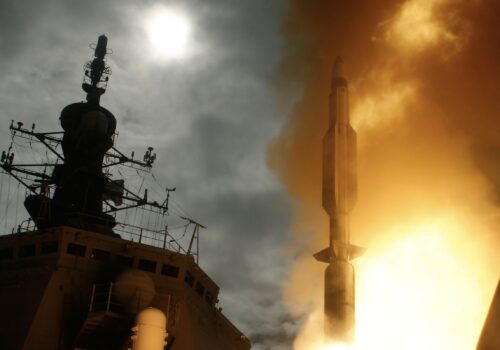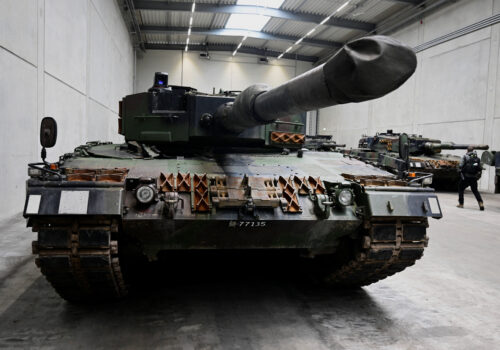How many missiles would the United States need in a conflict in the Indo-Pacific? How much ammunition? Perhaps most important, by how much do current stockpiles fall short of what would be needed in a war?
The first-ever US National Defense Industrial Strategy, published in 2022, sparked important discussions on these and other questions about the US defense industrial base. These questions in turn resulted in improvements across the strategy’s four strategic priorities: resilient supply chains, workforce readiness, flexible acquisition, and economic deterrence. Despite these improvements, however, a significant gap remains in producing the quantitative difference between peacetime stockpile requirements and the acute, continuous, and probable long-term demand needs during wartime.
Consider a hypothetical conflict with China in the Pacific. War games estimate that the United States could expend more than five thousand long-range missiles within the first few weeks of engagement. At the same time, several analysts and government agencies have highlighted the difficulty of replenishing weapons currently used in Ukraine—a much smaller-scale conflict compared to what should be anticipated in a war with China.
There are two ways to deal with this challenge: (1) enabling production in advance to stockpile and preposition equipment; and (2) replenishing materiel and stockpiles after hostilities have begun. However, the latter strategy often overlooks the complex challenge of rapidly increasing production to meet wartime demands, which could leave the United States vulnerable in the early stages of conflict.
Although the US government has begun investing in bolstering the defense industrial base, the current contracting system lacks the flexibility needed to transition from low demand to a rapid ramp-up of production to replenish depleted stockpiles. To address this issue, the United States should adopt an option contract model for armament procurement. This model involves the government paying a premium on current orders bought at the peacetime stockpile level with the option—but not the obligation—to purchase a significantly larger amount within a fixed timeframe, providing the defense industrial base with the necessary funds to develop and maintain rapid replenishment capabilities in the event of a conflict.
What are option contracts?
Like options in the stock market, an option contract grants the buyer—in this case, the US government—the right to purchase arms and ammunition at a preset price at a later date. If the government opts not to exercise this option, typically because peace prevails, the contractor retains the premium. This premium serves as a financial investment in future rapid replenishment capability and a continued steady demand signal for the industry, encouraging readiness and innovation without requiring the government to maintain unnecessary and wasteful stockpiles.
How this would work in practice
To illustrate why option contracts would be an improvement over the current model of US armament procurement, take the case of Tomahawk missiles. A February 2023 Center for Strategic and International Studies report estimated that the United States would expend four hundred Tomahawk missiles in the first three weeks of a full-scale conflict with China. In 2022, the US Navy procured 154 Tomahawks to be bought over a three-year period, translating to an annual production rate of about fifty missiles. This rate is orders of magnitude lower than what would be required to replenish expenditures during a full-scale conflict.
Applying the proposed option contract model to this scenario, the Navy would pay a premium on its annual order of fifty missiles, with the option to purchase an additional four hundred missiles within a single year if needed. The contractor would use the premium to invest in the capacity to scale up production, ensuring that the company can meet the full contract requirements on short notice if the need arose. This approach not only provides the contractor with the capital to enhance its production infrastructure and an incentive to maintain overcapacity, but also ensures that the United States has a ready supply of crucial munitions in times of need.
There are four main benefits of the option contract model:
- Enhanced production readiness: By providing a financial incentive upfront, the option contract model enables defense contractors to invest in infrastructure and workforce improvements as a reserve that can be rapidly scaled up in response to a crisis.
- Improved flexibility: This model allows the US government to lock in production capacity without committing to immediate full-scale procurement, balancing budget constraints with strategic readiness. This also helps meet small increases in demand in the event of smaller-scale conflicts.
- Stimulated industry investment: The premium paid on option contracts signals sustained demand, encouraging defense contractors to prioritize and invest in production capabilities and innovation, rather than stock buybacks or similar programs that benefit shareholders at the expense of the government.
- Mitigated risk: This approach hedges geopolitical risk, ensuring necessary arms and ammunition are available in short order during critical, unforeseen contingencies.
At the same time, several challenges must be addressed:
- Potential for rising costs: The premium paid for option contracts will increase procurement costs. Military programs are generally under-resourced in the constrained budget environment, so the rising procurement costs could lead to lower peacetime stockpile levels. If the increased capacity is never utilized, the premium paid may be viewed as government waste. However, the money spent on training the workforce and expanding capacity may be partially recouped by savings in follow-on contracts. A detailed cost-benefit analysis is essential to ensure that the increased expenditure aligns with strategic needs and budgetary constraints.
- Difficulties negotiating contracts: Establishing effective option contracts requires careful negotiation to define terms, production capabilities, and performance metrics, ensuring that both the government and contractors meet their obligations. The military-industrial base has not utilized these types of contracts in the past. This unfamiliarity could add time to complete what are currently straightforward contracts.
- Limits to industry capacity: Not all defense contractors have the capacity to scale up production rapidly, especially with “exquisite” weapon systems, which often involve high-end technology, are difficult and expensive to produce at scale, and require numerous subcontractors to complete. It is crucial, therefore, to assess the capability of industry partners and ensure that they can meet the demands of an option contract. There would need to be a requirement for the contractor to demonstrate the ability to surge its production to ensure good-faith use of the premium.
The option contract model represents a viable solution to address the current shortcomings in the US defense industrial base for some munitions. By incentivizing contractors with upfront premiums, this approach can enhance production readiness, flexibility, and industry investment, ultimately ensuring that the United States is better prepared to meet the demands of future conflicts.
Michael Hogan is the 2024-2025 senior US Navy fellow at the Atlantic Council’s Scowcroft Center for Strategy and Security.
The opinions expressed are those of the author and do not reflect the views or policy of the US Defense Department, the Department of the Navy, or the US government.
Further reading
Thu, Oct 17, 2024
In a war against China, the US could quickly exhaust its weapons. A new Indo-Pacific defense initiative might be the answer.
New Atlanticist By Adam Kozloski
The new Partnership for Indo-Pacific Industrial Resilience could enable faster provisioning of resources to Taiwan, the Philippines, South Korea, or even the United States if a war breaks out.
Wed, Oct 9, 2024
European defense industrial woes need a transatlantic remedy
New Atlanticist By Kristen Taylor, Luka Ignac
To ensure its security, the European Union should collaborate more closely with the United States on defense industrial production.
Thu, Jun 27, 2024
Production diplomacy for deterrence, readiness, and resilience in the Indo-Pacific
Issue Brief By Andrew Brown, John T. Watts, Markus Garlauskas
Production diplomacy provides opportunities to protect supply chains, strengthen alliances and partnerships, enhance deterrence, and build defense readiness, though it is not without risks and challenges.
Image: US Marine Corps Cpl. Carter Hughes, a combat engineer with Alpha Company, 9th Engineer Support Battalion, 3d Marine Logistics Group, carries a 155mm artillery round while conducting explosive ordnance disposal operations on Range 10, Camp Schwab, Okinawa, Japan, July 13, 2021. (US Marine Corps photo by Sgt. Hailey D. Clay)



